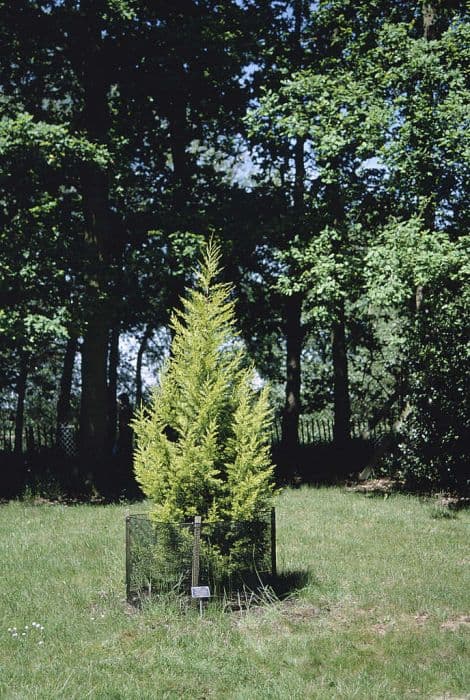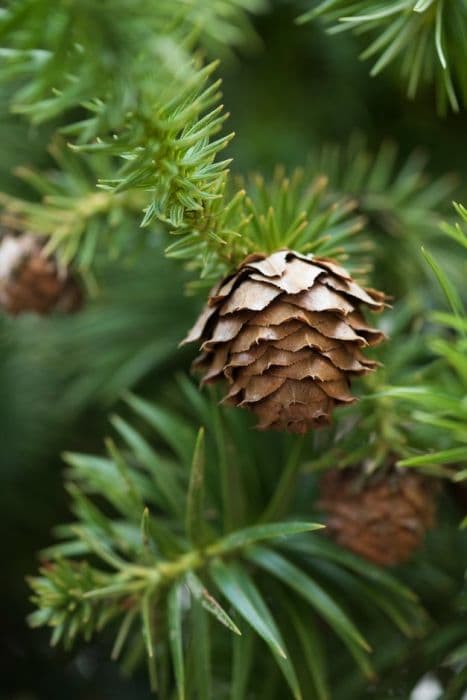Lawson Cypress Chamaecyparis lawsoniana 'Grayswood Pillar'











ABOUT
The Chamaecyparis lawsoniana 'Grayswood Pillar', commonly known as Lawson's Cypress 'Grayswood Pillar', is a visually striking conifer that features lush, evergreen foliage, making it a year-round interest in the garden. The plant has a narrowly columnar form which gives it a strong vertical presence. Its foliage comes in a beautiful shade of vibrant green, with the fine, feathery leaves creating a soft texture that stands out against the landscape. Its leaves are arranged in a flattened sprays pattern, contributing to the dense and compact appearance of the plant. As with most varieties of Lawson's Cypress, the 'Grayswood Pillar' has small cones that may not be particularly conspicuous but add some visual interest upon closer inspection. These cones start off a greenish color and mature to a brown hue as they age. The bark of the plant is fibrous and can have a reddish-brown color, giving it a rugged, natural look. Overall, the Lawson's Cypress 'Grayswood Pillar' is notable for its slim, upright shape and its lush, year-round greenery, offering an attractive addition to a variety of garden settings.
About this plant
 Names
NamesFamily
Cupressaceae.
Synonyms
Lawson's Cypress, Oregon Cedar, Port Orford Cedar.
Common names
Chamaecyparis lawsoniana 'Grayswood Pillar'.
 Toxicity
ToxicityTo humans
The plant commonly known as Lawson's Cypress is generally not considered highly toxic to humans. However, some individuals may experience allergic reactions or skin irritation when handling the plant, as it can contain allergenic compounds. If ingested, the plant material could potentially cause gastrointestinal discomfort or irritation. It is not commonly associated with severe poisoning or life-threatening symptoms in humans, but it is still advisable to avoid eating any parts of the plant.
To pets
The Lawson's Cypress is not typically listed as a highly toxic plant for pets. While it might not be severely poisonous, ingestion could lead to mild gastrointestinal upset in some animals, such as vomiting or diarrhea. It is always a good practice to discourage pets from chewing on or consuming parts of this or any ornamental plant to prevent any potential adverse reactions.
 Characteristics
CharacteristicsLife cycle
Perennials
Foliage type
Evergreen
Color of leaves
Green
Height
15 feet (4.57 meters)
Spread
4 feet (1.22 meters)
Plant type
Tree
Hardiness zones
5
Native area
North America
Benefits
 General Benefits
General Benefits- Aesthetic Appeal: The Lawson Cypress 'Grayswood Pillar' offers an elegant, upright shape, adding vertical interest and architectural form to the garden.
- Low Maintenance: Once established, it is relatively low maintenance, requiring minimal care beyond occasional pruning to maintain its shape.
- Evergreen Foliage: Its evergreen leaves provide year-round color and texture, which is particularly valuable during the drab winter months.
- Wildlife Habitat: The dense foliage offers shelter and nesting sites for birds and other wildlife.
- Privacy Screen: Due to its height and growth habit, it can be used as an effective privacy screen or windbreak.
- Drought Tolerance: Once established, the plant has a good level of drought tolerance, making it suitable for regions with less frequent rainfall.
- Soil Adaptability: It can adapt to a wide range of soil types, though it prefers moist, well-drained conditions.
- Resistances: The Lawson Cypress 'Grayswood Pillar' shows resistance to many pests and diseases, reducing the need for chemical treatments.
 Medical Properties
Medical PropertiesThis plant is not used for medical purposes.
 Air-purifying Qualities
Air-purifying QualitiesThis plant is not specifically known for air purifying qualities.
 Other Uses
Other Uses- Lawson's Cypress wood shavings can be used in the craft of wood-turning, producing beautiful, aromatic items such as bowls and vases.
- Smaller branches of Lawson's Cypress can be used for creating intricate wreaths or holiday ornaments due to their soft foliage and pleasant scent.
- Chips and sawdust from Lawson's Cypress can be used as natural mulch in gardening, providing a clear, insect-repellent ground cover.
- The dense foliage of Lawson's Cypress can be used as a sound barrier when planted in thick rows along highways or noisy areas.
- Lawson's Cypress can be incorporated into landscape designs as a living fence or privacy screen due to its tall and narrow growth habit.
- The wood can be crafted into furniture, offering a durable and visually appealing option for indoor or outdoor pieces.
- Thick hedges of Lawson's Cypress can be used as windbreaks, protecting smaller, less hardy plants from strong winds.
- The tree's wood, when finely ground, can be added to compost as a source of carbon to improve soil structure and fertility.
- When dried, the foliage of Lawson's Cypress can be used in potpourri mixtures for a long-lasting and natural forest scent.
- Lawson's Cypress trees can be utilized in bonsai culture, providing a challenge to growers due to their fast growth and need for careful shaping.
Interesting Facts
 Feng Shui
Feng ShuiThe Lawson's Cypress is not used in Feng Shui practice.
 Zodiac Sign Compitability
Zodiac Sign CompitabilityThe Lawson's Cypress is not used in astrology practice.
 Plant Symbolism
Plant Symbolism- Longevity: Chamaecyparis lawsoniana, commonly known as Lawson's cypress, is an evergreen conifer which symbolizes enduring life due to its longevity and perennial growth.
- Protection: Many cypress species are considered symbols of protection, as historically they've been planted in graveyards to protect the dead; Lawson's cypress may similarly symbolize shelter and safeguarding.
- Peace: Cypress trees are often associated with serenity and peace, perhaps because of their use in tranquil cemetery settings.
- Purity: The evergreen nature of Lawson's cypress represents purity and cleanliness, with its constant green foliage symbolizing a steady and untainted presence.
 Water
WaterLawson's Cypress 'Grayswood Pillar' should be watered deeply and thoroughly, allowing the soil to become slightly dry between waterings. Young trees especially need regular watering to establish their root systems. In general, provide about 1 to 2 gallons of water per week, adjusting for rainfall, humidity, and temperature. During hot, dry spells, water twice a week. In winter or cooler weather, reduce watering frequency to prevent soggy soil, which can lead to root rot.
 Light
LightLawson's Cypress 'Grayswood Pillar' thrives in full sun to partial shade. The ideal location offers six or more hours of direct sunlight daily. Too much shade can lead to sparse growth and a decrease in the ornamental value of this conifer. Ensure it's planted in a spot that meets its light requirements to maintain a healthy, dense form.
 Temperature
TemperatureLawson's Cypress 'Grayswood Pillar' is hardy and can withstand a range of temperatures, with an ideal growing range between 60°F and 75°F. It can survive minimum temperatures down to about -20°F. However, it may suffer from foliage burn or damage if exposed to extreme temperature fluctuations or sustained temperatures below its cold hardiness limit.
 Pruning
PruningLawson's Cypress 'Grayswood Pillar' requires minimal pruning, mainly to shape the tree or remove dead or damaged branches. Pruning is best done in late winter or early spring before new growth starts. Occasional thinning helps maintain the desired form and increases light penetration and air circulation, which can reduce disease risk.
 Cleaning
CleaningAs needed
 Soil
SoilThe best soil mix for Lawson's Cypress ‘Grayswood Pillar’ is well-draining, loamy soil with a slightly acidic to neutral pH of 5.5 to 7.0. Amend garden soil with organic matter like compost or peat moss to improve drainage and nutrient content.
 Repotting
RepottingLawson's Cypress ‘Grayswood Pillar’ does not typically require repotting as it is usually planted directly in the ground. If grown in containers, repot every 2 to 3 years to refresh the soil and encourage healthy growth.
 Humidity & Misting
Humidity & MistingLawson's Cypress ‘Grayswood Pillar’ thrives in moderate humidity conditions. It does not require special humidity adjustments when planted outdoors in its appropriate climate zones.
 Suitable locations
Suitable locationsIndoor
Ensure bright light, cool temps, and good air circulation.
Outdoor
Plant in full sun, well-draining soil, and protect from strong winds.
Hardiness zone
5-8 USDA
 Life cycle
Life cycleChamaecyparis lawsoniana 'Grayswood Pillar', commonly known as Lawson's Cypress 'Grayswood Pillar', begins its life as a seed that germinates in moist, well-drained soil. The seedling stage is followed by a period of rapid juvenile growth, where the young tree develops its root system and foliage. As it enters the mature stage, 'Grayswood Pillar' takes on its characteristic narrow, columnar form and its foliage becomes denser. This conifer continues to grow slowly, reaching substantial heights over many years, and is often used as a vertical accent in landscape design. Once mature, it produces small cones that mature and release seeds to perpetuate the species. Lawson's Cypress 'Grayswood Pillar' can live for several decades, remaining evergreen throughout its lifespan before eventually succumbing to old age or environmental stresses.
 Propogation
PropogationPropogation time
Late winter to early spring
The Lawson cypress 'Grayswood Pillar' is most commonly propagated through semi-hardwood cuttings. The ideal time for taking cuttings is in late summer to early fall. The process starts with selecting healthy semi-hardwood shoots from the current season's growth, typically around 4 to 6 inches (10 to 15 cm) long. The lower leaves of the cuttings are removed, and the cut end is dipped in rooting hormone powder to promote root development. The cuttings are then inserted into a mix of peat and perlite or a similar rooting medium. They should be placed in a well-ventilated area with indirect light and high humidity. Maintaining a consistent temperature around 70°F (21°C) can encourage rooting. After a few weeks under these conditions, cuttings should begin to form roots, after which they can be gradually acclimated to outdoor conditions before planting out.









